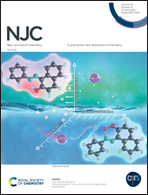Combination of alkali treatment and Ag3PO4 loading effectively improves the photocatalytic activity of TiO2 nanoflowers†
Abstract
In this paper, three-dimensional TiO2 nanoflowers (NFs) were prepared by a facile hydrothermal method, and Ag3PO4 was grown in situ following alkali treatment to design and synthesize a Ag3PO4/OH/TiO2 catalyst with excellent photocatalytic activity under visible light. The test results show that the photocatalytic degradation performance of TiO2 NFs after alkali treatment and Ag3PO4 loading is significantly improved. This is because the alkali treatment and the introduction of Ag3PO4 can provide a large amount of –OH, which can be converted to ˙OH under UV irradiation, followed by an increase in the number of active radicals to enhance the photocatalytic degradation performance. Meanwhile, the introduction of Ag3PO4 can effectively improve the light absorption ability of the photocatalyst. Moreover, the in situ growth of Ag3PO4 on TiO2 NFs can construct a high-quality Ag3PO4/TiO2 heterojunction to promote the charge separation and transport. Therefore, the degradation rate of Ag3PO4/OH/TiO2 can reach 90% after 30 min for degrading 3 mg L−1 RhB under visible light. The Ag3PO4/OH/TiO2 photocatalyst designed in the present work provides a new tool for the degradation of organic dyes.



 Please wait while we load your content...
Please wait while we load your content...